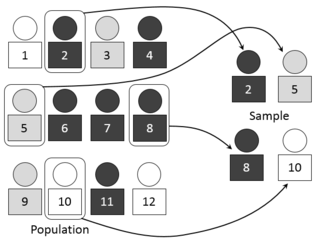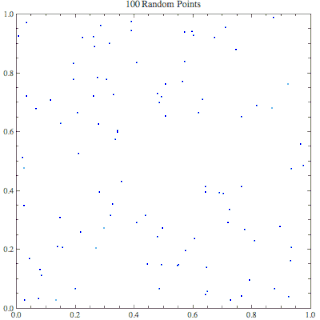Related Research Articles

In statistics, Cluster sampling is a sampling plan used when mutually homogeneous yet internally heterogeneous groupings are evident in a statistical population. It is often used in marketing research. In this sampling plan, the total population is divided into these groups and a simple random sample of the groups is selected. The elements in each cluster are then sampled. If all elements in each sampled cluster are sampled, then this is referred to as a "one-stage" cluster sampling plan. If a simple random subsample of elements is selected within each of these groups, this is referred to as a "two-stage" cluster sampling plan. A common motivation for cluster sampling is to reduce the total number of interviews and costs given the desired accuracy. For a fixed sample size, the expected random error is smaller when most of the variation in the population is present internally within the groups, and not between the groups.
The gambler's fallacy, also known as the Monte Carlo fallacy or the fallacy of the maturity of chances, is the incorrect belief that if a particular event occurs more frequently than normal during the past it is less likely to happen in the future, when it has otherwise been established that the probability of such events does not depend on what has happened in the past. Such events, having the quality of historical independence, are referred to as statistically independent. The fallacy is commonly associated with gambling, where it may be believed, for example, that the next dice roll is more than usually likely to be six because there have recently been fewer than the usual number of sixes.
In statistics, sampling bias is a bias in which a sample is collected in such a way that some members of the intended population have a lower or higher sampling probability than others. It results in a biased sample of a population in which all individuals, or instances, were not equally likely to have been selected. If this is not accounted for, results can be erroneously attributed to the phenomenon under study rather than to the method of sampling.

Statistics is the discipline that concerns the collection, organization, analysis, interpretation, and presentation of data. In applying statistics to a scientific, industrial, or social problem, it is conventional to begin with a statistical population or a statistical model to be studied. Populations can be diverse groups of people or objects such as "all people living in a country" or "every atom composing a crystal". Statistics deals with every aspect of data, including the planning of data collection in terms of the design of surveys and experiments.
In statistics, survey sampling describes the process of selecting a sample of elements from a target population to conduct a survey. The term "survey" may refer to many different types or techniques of observation. In survey sampling it most often involves a questionnaire used to measure the characteristics and/or attitudes of people. Different ways of contacting members of a sample once they have been selected is the subject of survey data collection. The purpose of sampling is to reduce the cost and/or the amount of work that it would take to survey the entire target population. A survey that measures the entire target population is called a census. A sample refers to a group or section of a population from which information is to be obtained

In statistics and quantitative research methodology, a sample is a set of individuals or objects collected or selected from a statistical population by a defined procedure. The elements of a sample are known as sample points, sampling units or observations. When conceived as a data set, a sample is often denoted by capital roman letters such and , with its elements expressed in lower-case and the sample size denoted by the letter .

In statistics, quality assurance, and survey methodology, sampling is the selection of a subset of individuals from within a statistical population to estimate characteristics of the whole population. Statisticians attempt for the samples to represent the population in question. Two advantages of sampling are lower cost and faster data collection than measuring the entire population.
Sampling is the use of a subset of the population to represent the whole population or to inform about (social) processes that are meaningful beyond the particular cases, individuals or sites studied. Probability sampling, or random sampling, is a sampling technique in which the probability of getting any particular sample may be calculated. Nonprobability sampling does not meet this criterion. Nonprobability sampling techniques are not intended to be used to infer from the sample to the general population in statistical terms. Instead, for example, grounded theory can be produced through iterative nonprobability sampling until theoretical saturation is reached.
Selection bias is the bias introduced by the selection of individuals, groups, or data for analysis in such a way that proper randomization is not achieved, thereby ensuring that the sample obtained is not representative of the population intended to be analyzed. It is sometimes referred to as the selection effect. The phrase "selection bias" most often refers to the distortion of a statistical analysis, resulting from the method of collecting samples. If the selection bias is not taken into account, then some conclusions of the study may be false.

The clustering illusion is the tendency to erroneously consider the inevitable "streaks" or "clusters" arising in small samples from random distributions to be non-random. The illusion is caused by a human tendency to underpredict the amount of variability likely to appear in a small sample of random or semi-random data.

Field experiments are experiments carried out outside of laboratory settings.
In sociology and statistics research, snowball sampling is a nonprobability sampling technique where existing study subjects recruit future subjects from among their acquaintances. Thus the sample group is said to grow like a rolling snowball. As the sample builds up, enough data are gathered to be useful for research. This sampling technique is often used in hidden populations, such as drug users or sex workers, which are difficult for researchers to access. As sample members are not selected from a sampling frame, snowball samples are subject to numerous biases. For example, people who have many friends are more likely to be recruited into the sample. When virtual social networks are used, then this technique is called virtual snowball sampling.
Quota sampling is a method for selecting survey participants that is a non-probabilistic version of stratified sampling.
In statistics, a sampling frame is the source material or device from which a sample is drawn. It is a list of all those within a population who can be sampled, and may include individuals, households or institutions.
Bootstrapping is any test or metric that uses random sampling with replacement, and falls under the broader class of resampling methods. Bootstrapping assigns measures of accuracy to sample estimates. This technique allows estimation of the sampling distribution of almost any statistic using random sampling methods.
The analysis of clinical trials involves many related topics including:

Environmental monitoring describes the processes and activities that need to take place to characterize and monitor the quality of the environment. Environmental monitoring is used in the preparation of environmental impact assessments, as well as in many circumstances in which human activities carry a risk of harmful effects on the natural environment. All monitoring strategies and programs have reasons and justifications which are often designed to establish the current status of an environment or to establish trends in environmental parameters. In all cases, the results of monitoring will be reviewed, analyzed statistically, and published. The design of a monitoring program must therefore have regard to the final use of the data before monitoring starts.
In survey sampling, total survey error includes all forms of survey error including sampling variability, interviewer effects, frame errors, response bias, and non-response bias. Total survey error is discussed in detail in many sources including Salant and Dillman.
With the application of probability sampling in the 1930s, surveys became a standard tool for empirical research in social sciences, marketing, and official statistics. The methods involved in survey data collection are any of a number of ways in which data can be collected for a statistical survey. These are methods that are used to collect information from a sample of individuals in a systematic way. First there was the change from traditional paper-and-pencil interviewing (PAPI) to computer-assisted interviewing (CAI). Now, face-to-face surveys (CAPI), telephone surveys (CATI), and mail surveys are increasingly replaced by web surveys.
Convenience sampling is a type of non-probability sampling that involves the sample being drawn from that part of the population that is close to hand. This type of sampling is most useful for pilot testing.
References
- Deming, W. Edwards (1990). Sample Design in business research. John Wiley and Sons. p. 31. ISBN 0-471-52370-4.
- "Judgmental Sampling". Explorable.com. September 13, 2009. Retrieved March 25, 2018.
- "What is Expert Sampling?". statisticshowto. 12 October 2017. Retrieved March 25, 2018.